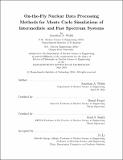| dc.contributor.advisor | Benoit Forget and Kord S. Smith. | en_US |
| dc.contributor.author | Walsh, Jonathan A. (Jonathan Alan) | en_US |
| dc.contributor.other | Massachusetts Institute of Technology. Department of Nuclear Science and Engineering. | en_US |
| dc.date.accessioned | 2017-01-30T18:51:14Z | |
| dc.date.available | 2017-01-30T18:51:14Z | |
| dc.date.copyright | 2016 | en_US |
| dc.date.issued | 2016 | en_US |
| dc.identifier.uri | http://hdl.handle.net/1721.1/106700 | |
| dc.description | Thesis: Ph. D., Massachusetts Institute of Technology, Department of Nuclear Science and Engineering, 2016. | en_US |
| dc.description | This electronic version was submitted by the student author. The certified thesis is available in the Institute Archives and Special Collections. | en_US |
| dc.description | Cataloged from student-submitted PDF version of thesis. | en_US |
| dc.description | Includes bibliographical references (pages 203-212). | en_US |
| dc.description.abstract | Computational methods for on-the-fly representation and processing of nuclear data within Monte Carlo neutron transport simulations of intermediate and fast spectrum systems are developed and implemented in a continuous-energy Monte Carlo code. First, a capability to compute temperature-dependent unresolved resonance region (URR) cross sections directly from zero-temperature average resonance parameters is presented. The use of this capability in benchmarking both evaluated and processed URR data is demonstrated. Results of this benchmarking lead to a partial resolution of a longstanding discrepancy between experiment and calculation results for a well-known fast critical assembly. Next, an on-the-fly probability table interpolation scheme for computing temperature-dependent URR cross sections is developed and used in analyses which show that interpolation on a relatively coarse temperature mesh (>100 K) can be used to reproduce results obtained with cross sections generated at an exact temperature. This enables the simulation of systems having detailed temperature distributions using probability table data which require significantly less memory than data generated on a fine temperature mesh. Additional methods for use in the investigation of two common approximations that are made in representing URR cross section data are developed. Namely, a multi-level URR cross section calculation capability is used to show that level-level interference effects in elastic scattering cross sections are negligible in many cases of interest. A capability to generate resonance structure in competitive reaction cross sections is used to show that neglecting cross section structure for reactions other than elastic scattering, capture, and fission can lead to non-negligible, unconservative biases (>100 pcm) in criticality safety calculations. The principal underlying assumption of the probability table method is also tested by comparing the results it yields with results that are averaged over many independent simulations, each using a single, independent realization of URR resonance parameters. Unknown URR resonance structure is observed to induce an uncertainty on the multiplication factor for intermediate and fast spectrum systems that is nearly an order of magnitude greater than that which is purely stochastic. This significantly increases the uncertainty to which results of simulations of those systems should be stated. Finally, a procedure for consistent, on-the-fly sampling of temperature-dependent neutron reaction kernels which requires no additional secondary distribution data is presented. It is used to show that Doppler effects may have only a small impact on elastic scattering secondary angular distributions at typical power reactor operating temperatures but can be appreciable at astrophysical temperatures. | en_US |
| dc.description.statementofresponsibility | by Jonathan A. Walsh. | en_US |
| dc.format.extent | 212 pages | en_US |
| dc.language.iso | eng | en_US |
| dc.publisher | Massachusetts Institute of Technology | en_US |
| dc.rights | MIT theses are protected by copyright. They may be viewed, downloaded, or printed from this source but further reproduction or distribution in any format is prohibited without written permission. | en_US |
| dc.rights.uri | http://dspace.mit.edu/handle/1721.1/7582 | en_US |
| dc.subject | Nuclear Science and Engineering. | en_US |
| dc.title | On-the-fly nuclear data processing methods for Monte Carlo simulations of intermediate and fast spectrum systems | en_US |
| dc.type | Thesis | en_US |
| dc.description.degree | Ph. D. | en_US |
| dc.contributor.department | Massachusetts Institute of Technology. Department of Nuclear Science and Engineering | |
| dc.identifier.oclc | 969901587 | en_US |
